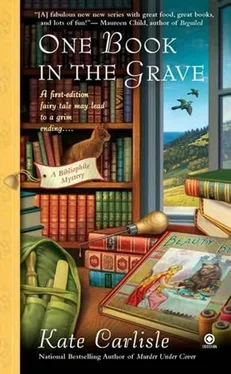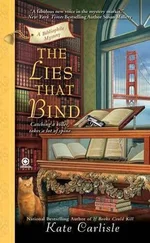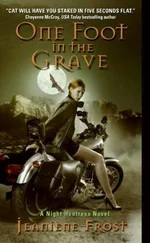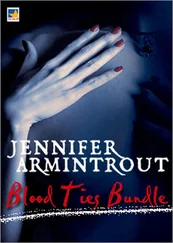I picked up the first book and checked the spine. The Woman in White . Its tiny painting depicted a woman in a billowy white dress standing on the bank of a lake with rippling water in the background. The detail was wonderful. It was lucky that the miniature paintings were protected by glass, because they all appeared to be in perfect condition, unlike the books themselves.
I checked the copyright page and found it was printed in 1860. I quickly looked up the publication date online and realized that this book might be a first edition. I would have to check other sources, but I had no doubt that the book was extremely valuable. While online, I also discovered that Collins had written twenty-three novels. The box Grace had given me contained only six books. I had to wonder whether there were more hidden throughout her rambling home that were in need of rescue.
Closing the cover, I turned the book over and carefully began to thumb through the gilded pages. That’s when I discovered the fore-edge painting.
“Oh, my God,” I whispered. Was the entire collection painted? If so, the books were beyond priceless. The set belonged in a museum. I wondered if Grace would consent to donating them to the Covington Library.
The technique of fore-edge painting came into popular practice in the 1800s, and it was done by fanning the pages and clamping the book tightly. Then an artist would paint a watercolor painting on the fanned edge. When dry, the book would be clamped at its normal angle and the fore edge would be gilded in the typical way.
So when the book was closed, it would appear to be a normal, gilt-edged book. The painting couldn’t be seen unless the fore edge was fanned. It was a charming surprise for any antiquarian book lover.
Some of the antiquarian books sold these days contained edge paintings that had been added more recently. There were artists who specialized in edge painting, and I’d worked with one talented but eccentric fellow a few years ago. It wasn’t the sort of art you could hang on a wall and he was a little bitter about that, but his art was his master, or so he claimed.
But the fore-edge painting on this copy of The Woman in White was as old as the book itself and, thankfully, in excellent condition. The cover, however, wasn’t so lucky; it was fully separated from the spine. The back cover was in even worse shape. The leather had disintegrated, the hard board beneath was crumbling, and one edge had been nibbled badly. It hurt my heart.
“Sad little book,” I murmured. Yet when I fanned the fore edge, a sweet bucolic scene emerged of a shepherd boy and a flock of sheep grazing in a vast green field. “Amazing.”
I opened the book and turned the pages slowly. There were a number of beautiful steel-engraved illustrations throughout. Strangely enough, the paper was still in good condition, with only light foxing, as far as I could see. I would have to check the others, but with any luck, they would be in the same decent shape.
I poured myself another cup of coffee, took a quick sip, then left the cup on my desk as usual. I never drank any liquids when I was working. Spilled coffee and old books didn’t play well together.
As I reached for the next Collins, The Moonstone , I was already planning my strategy for restoring the set of six. I had several sheets of beautiful morocco leather dyed a deep navy blue, enough to cover all six books easily. It would be a challenge to resew and rebind them with their original fore-edge paintings, but I looked forward to it. I tested my strongest book press and was confident that it would hold each book in place as I resewed the signatures.
I spent most of that day in my sweats, going through every page of every book in Grace’s Wilkie Collins collection. As with the The Woman in White , most of the paper was in good condition. A good thing, because the less work I had to do on the pages themselves, the less I would upset the natural lay of the fore-edge paintings. A tear or a replaced page would present a real challenge, so I was happy not to have to face that possibility.
After three days of working on the Wilkie Collins collection, I’d finished only two books and I needed a break.
It seemed that all of us were stalled in finding further information about Angelica and Solomon. Derek’s office was in turmoil, so his time spent investigating weapons sales to the survivalists had taken a backseat.
I was happy I had my own work to do, because I would have gone stir crazy otherwise. Max seemed a little closer to the brink, although he managed to keep busy, as well.
Despite Derek’s distractions, he’d taken the time to arrange for one of his assistants to pick up my car from the police, run it through the car wash, and fill it with gas, then deliver it to my home. I was thrilled to have my car back, even though I wasn’t about to leave the house while there was a killer on the loose.
Monday morning, after Derek left for a meeting with clients, I took a break from the Wilkie Collins books and turned my attention to Beauty and the Beast . I’d received permission from Max to restore the book, even though he and Emily had originally insisted they wanted it left in its shabby condition. I gave him all sorts of reasons why it should be cleaned and rebound, but the reason that swayed him most was that the book had spent three years in the hands of someone who had shown ill will toward Max and Emily. Those bad vibes needed to be exorcised, and I was just the bookbinder to wipe them clean.
I didn’t bring up the fact that the book had once belonged to me and part of me felt that it was back where it belonged. I certainly planned to turn it over to Emily and Max if they got back together again, but if the book really was mine, I would want to give it a shiny new cover. So that’s what I was going to do.
That had been Ian’s wish, too. Even if Emily and Max did reunite, I was hoping I could convince them to donate the book to the Covington after all.
In one of my map drawers where I kept sheets of leather, I found a beautiful piece of soft morocco in a spectacular shade of vermilion. I’d been saving it for the perfect project, and this was it. The color reminded me of the crimson paper Max had created from the juice and pulp of his homegrown beets.
I shuffled through the bags from Max’s house and found the red paper among the many sheets I’d collected from his basement.
When I held up the paper next to the piece of leather to compare the colors, I was thrilled. The two shades complemented each other perfectly. I decided at that moment that I would build a storage box for Beauty and use Max’s thick crimson sheets of paper for the lining.
The style of box I had in mind was commonly known as a clamshell because of its construction. A hinge on one side allowed it to spread open completely and reveal its contents, somewhat like the action of a clamshell. Most jewelry boxes opened this way, and many rare books were housed in similar style.
Max, meanwhile, had discovered that one of the doors in my living room led upstairs to my small, private rooftop patio, and he had taken over the space. Moving the patio table and chairs around, he set up a makeshift papermaking studio in the southeast corner, where the walls blocked the worst of San Francisco’s winds.
He laid out his tools and supplies, then went around my house, pruning the plants and small trees I had in pots inside and out on the patio. He gathered quite a selection of twigs and leaves and petals that he would use to work into the sheets of paper he would make. I loaned him a week’s worth of newspapers for turning into pulp, as well as my hair dryer, to speed up the drying process, and he was good to go.
I spent the afternoon in my workroom, studying the endpapers of Beauty and the Beast . They were worth saving. There was a fanciful rendering of a magical forest in shades of green and brown and gold that would work beautifully against the vermilion leather. The details of the forest were charming. Cheerful flowers lined a winding path that led deeper into the woods. Small forest creatures flitted among the trees. The picture was faded but still engaging, so I was extra careful to make a clean, razor-sharp cut along the inner hinge. I would splice the two sides together later and the little work of art would look as good as new.
Читать дальше












